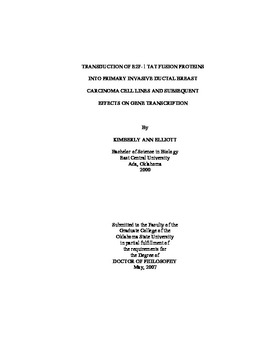| dc.contributor.advisor | Rickords, Lee F. | |
| dc.contributor.author | Elliott, Kimberly Ann | |
| dc.date.accessioned | 2013-11-26T08:22:51Z | |
| dc.date.available | 2013-11-26T08:22:51Z | |
| dc.date.issued | 2007-05 | |
| dc.identifier.uri | https://hdl.handle.net/11244/6641 | |
| dc.description.abstract | Scope and Method of Study: Breast carcinomas harbor specific genetic alterations that contribute to their immortalized state, including overexpression of telomerase and p53 tumor suppressor gene mutations. E2F-1 is a known transcriptional repressor of the catalytic subunit of telomerase, hTERT. In p53 mutated cells, E2F-1 possesses the ability to transactivate the p73 tumor suppressor pathway and p53-homologues involved in cell cycle arrest such as p21WAF1/CIP1. We investigated an alternative method of introducing the E2F-1 transcription factor via Tat-mediated protein transduction to effectively target and reversibly impact gene expression in breast cancer cell lines. Using affinity chromatography, the E2F-1 Tat fusion proteins were isolated and purified via FPLC and dialysis. Real-time RT-qPCR was utilized to assess the effects of E2F-1 Tat fusion protein treatment on gene expression of breast carcinomas. We investigated repression of hTERT and induction of p73 and p21WAF1/CIP1 genes in HCC1937 and HCC1599 primary invasive ductal breast cancer cell lines. Following cell treatment with E2F-1 Tat protein therapy, apoptotic activity was monitored via TUNEL assays. | |
| dc.description.abstract | Findings and Conclusions: The E2F-1 Tat fusion proteins effectively transduced greater than 95% of cancer cells. Protein therapy with E2F-1/TatHA repressed expression of hTERT by 3.5-fold in HCC1937 cells and by 4.0-fold in HCC1599 cells versus control proteins. Treatment of HCC1937 and HCC1599 carcinoma cells with E2F-1 Tat fusion proteins resulted in greater than 2-fold induction of p73 gene expression. Upregulation of the p53 responsive gene, p21WAF1/CIP1, was observed in HCC1937 and HCC1599 cells following treatment with E2F-1 Tat proteins. A 3.3-fold induction of p21WAF1/CIP1 was observed in HCC1937 cells versus a smaller induction of 1.4-fold in HCC1599 cells, which was attributed to the presence of a BRCA1 mutation in HCC1599 cells. Following 24 hours of treatment with E2F-1 Tat fusion proteins, apoptotic activity was detected in approximately 10% of breast cancer cells versus control proteins. Overall, the E2F-1 Tat protein therapy proved to be a moderately effective repressor of hTERT and activator of both p73 and p21WAF1/CIP1 resulting in detectable apoptotic activity. This suggests a potential application of E2F-1 Tat protein therapy in cancer therapeutics to modulate gene expression in breast carcinomas. | |
| dc.format | application/pdf | |
| dc.language | en_US | |
| dc.rights | Copyright is held by the author who has granted the Oklahoma State University Library the non-exclusive right to share this material in its institutional repository. Contact Digital Library Services at lib-dls@okstate.edu or 405-744-9161 for the permission policy on the use, reproduction or distribution of this material. | |
| dc.title | Transduction of E2F-1 Tat fusion proteins into primary invasive ductal breast carcinoma cell lines and subsequent effects on gene transcription | |
| dc.contributor.committeeMember | Allen, Robert W. | |
| dc.contributor.committeeMember | Evans, Paul | |
| dc.contributor.committeeMember | Malayer, Jerry Rhea | |
| osu.filename | Elliot_okstate_0664D_2194.pdf | |
| osu.accesstype | Open Access | |
| dc.type.genre | Dissertation | |
| dc.type.material | Text | |
| dc.subject.keywords | telomerase | |
| dc.subject.keywords | protein therapy | |
| dc.subject.keywords | breast cancer | |
| dc.subject.keywords | apoptosis | |
| dc.subject.keywords | Tat | |
| dc.subject.keywords | p73 | |
| thesis.degree.discipline | Biochemistry and Molecular Biology | |
| thesis.degree.grantor | Oklahoma State University | |
